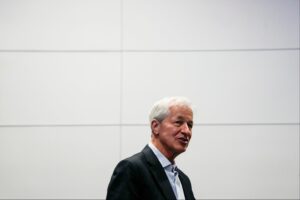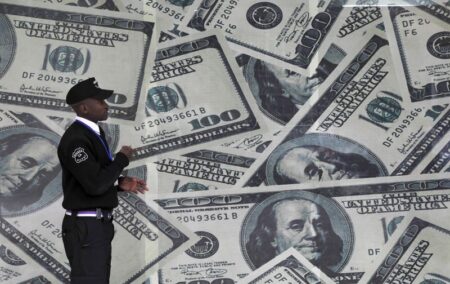By Alun John
LONDON (Reuters) – Sterling just had its best year against the dollar since 2017, yet a weakening economy and election uncertainty make a repeat performance unlikely.
It is not hard to see why investors flocked back to Britain’s currency after it hit a record low only 16 months ago: the economy did better than feared, sticky inflation meant the Bank of England was set to wait longer than its peers with monetary easing and the dollar’s appeal waned on expectations for an early U.S. rate cut.
The pound, trading near $1.28, rose almost 6% last year against the dollar – making it the second-best performing major currency after the Swiss franc.
It is also quite far from an all-time low of $1.0327 it hit in 2022 when then Prime Minister Liz Truss rattled markets by proposing unfunded tax cuts.
While this puts sterling on stronger ground heading into a likely election year, the rally’s drivers are losing momentum.
First is the fading impact of interest-rate differentials, a major influence in the $7.5 trillion-a-day global currency market.
Jane Foley, head of currency strategy at Rabobank, said that while a perception that the BoE would lag European Central Bank and Federal Reserve policy easing had boosted sterling, this theme “had been thrown into disarray” by the latest economic data.
UK consumer price inflation eased sharply to 3.9% in November and British gross domestic product was revised downward to show a 0.1% contraction in the third quarter.
Britain might already be in recession, and it has seen the second weakest recovery from the COVID-19 pandemic in the Group of Seven after Germany.
The data prompted traders to bring forward expectations of a first BoE rate cut, with markets now fully pricing in a 25 basis point cut as soon as May compared with August just a few weeks ago.
“The upside for cable has started to look a little more complex,” said Foley, referring to the pound/dollar exchange rate.
“Without higher inflation or stronger growth we could see it top out below $1.30. Until the data, I was more confident we’d hit $1.30.”
Sterling is traditionally seen as a “risk currency”, moving in line with other such assets, most typically equities, and its recent gains have come as MSCI’s world stock index headed towards two-year highs.
With valuations becoming somewhat stretched, a global stocks reversal would be a further risk for the pound.
HSBC’s head of European currency research Dominic Bunning, said sterling’s rally from $1.20 in October to $1.27 in late November was “completely unjustified” from the perspective of interest rate differentials.
“Obviously, if you compare it to equity markets then it looks a lot more sensible,” he said. “That’s the battle that’s playing out. At the moment the equity driver is winning but we are sceptical as to whether that can persist.”
He expects sterling to weaken towards $1.20 this year due to British economic weakness, implying a fall of as much as 6% from current levels.
TALKING POLITICS
Another possible source of instability is the British election, which must take place by January 2025, but is anticipated this year, with polls favouring the opposition Labour Party.
The vote’s timing could impact sterling by affecting the timing of rate cuts as the BoE tries to avoid being seen as influencing the country’s mood around election time, Rabobank’s Foley said.
There may also be some caution ahead of a March 6 budget, which could contain new tax cuts, according to local media.
Michael Metcalfe, State Street (NYSE:) Global Markets’ head of macro strategy, reckons politicians may have learned their lessons from Truss’ budget debacle.
“Heading into an election year, that will mean promises of fiscal largesse will be moderate and funded,” he said.
To be sure, not all expect sterling weakness ahead, global economic uncertainty means there is much less consensus among forecasters compared to a year ago.
Goldman Sachs for example, sees the pound at $1.35 in 12 months’ time, boosted by calmer government bond markets and high equity prices.
Read the full article here












